The MADAG Strategy for Fault Location Techniques
Abstract
1. Introduction
1.1. Research Background and Motivation
1.2. Research Purpose
- How many test cases does MADGA need to achieve the same level of effectiveness of fault localization?
- Is it still efficient to apply the SBFL technique with the whole test cases?
2. Preliminary
2.1. Test Case Prioritization
2.2. Fault Localization Technique
3. The Proposed MADAG Strategy
3.1. Overview
3.2. MADAG Strategy
| Algorithm 1. MADAG |
| function MADAG(T) define denotes group id, and the group is a set that consists of statements denotes the number of statements of this group set the selected test case set the statements covered by the initial failed test case () as initial group G1 push into ST on level 1 (k = 1) such that ST = {} . k = 2; loop { select test cast ti in ST by calculating the Mi of each test case at the k level divide Gj into G2j and G2j+1 by division operation//Do(1,1), Do(1,0), Do(0,1), and Do(1,0) find the target test case ttarget that has the minimal value of on each level s.t. . ; if all of the selected test cases have the same value break;} return ST |
3.3. An Example
4. Empirical Study
4.1. Experimental Setups and Metrics
4.2. Subject Programs
4.3. Well-Known Similarity Coefficients of SBFL Technique
4.4. Experimental Results and Analysis
5. Discussion
5.1. Test Case Prioritization and Selection
5.2. Fault Localization
6. Conclusions
Author Contributions
Funding
Data Availability Statement
Conflicts of Interest
References
- Abreu, R.; Zoeteweij, P.; van Gemund, A.J.C. Spectrum-Based Multiple Fault Localization. In Proceedings of the IEEE/ACM International Conference on Automated Software Engineering (ASE), Auckland, New Zealand, 16–20 November 2009; pp. 88–99. [Google Scholar] [CrossRef]
- Abreu, R.; Zoeteweij, P.; Golsteijn, R.; Van Gemund, A.J. A practical evaluation of spectrum-based fault localization. J. Syst. Softw. 2009, 82, 1780–1792. [Google Scholar] [CrossRef]
- Zakari, A.; Abdullahi, S.; Shagari, N.M.; Tambawal, A.B.; Shanono, N.M.; Maitama, J.Z.; Abdulrahman, S.M. Spectrum-based fault localization techniques application on multiple-fault programs: A review. Glob. J. Comput. Sci. Technol. 2020, 20, G2. [Google Scholar] [CrossRef]
- Wen, M.; Chen, J.; Tian, Y.; Wu, R.; Hao, D.; Han, S.; Cheung, S.C. Historical spectrum based fault localization. IEEE Trans. Softw. Eng. 2019, 47, 2348–2368. [Google Scholar] [CrossRef]
- Wong, W.E.; Debroy, V.; Ruizhi, G.; Yihao, L. The DStar method for effective software fault localization. IEEE Trans. Reliab. 2013, 63, 290–308. [Google Scholar] [CrossRef]
- Godefroid, P.; Klarlund, N.; Sen, K. Dart: Directed automated random testing. In Proceedings of the ACM SIGPLAN Conference on Programming Language Design and Implementation, Chicago, IL, USA, 12–15 June 2005; pp. 213–223. [Google Scholar] [CrossRef]
- Ma, E.; Fu, X.; Wang, X. Scalable path search for automated test case generation. Electronics 2022, 11, 727. [Google Scholar] [CrossRef]
- Sen, K.; Marinov, D.; Agha, G. Cute: A concolic unit testing engine for c. In Proceedings of the ACM Joint European Software Engineering Conference and Symposium on the Foundations of Software Engineering (ESEC/FSE), Lisbon, Portugal, 5–9 September 2005; pp. 263–272. [Google Scholar]
- Yu, Y.; Jones, J.A.; Harrold, M.J. An empirical study of the effects of test-suite reduction on fault localization. In Proceedings of the 30th International Conference on Software Engineering (ICSE), Leipzig, Germany, 10–18 May 2008; pp. 201–210. [Google Scholar] [CrossRef]
- Hao, D.; Xie, T.; Zhang, L.; Wang, X.; Sun, J.; Mei, H. Test input reduction for result inspection to facilitate fault localization. J. Autom. Softw. Eng. 2010, 17, 5–31. Available online: https://link.springer.com/article/10.1007/s10515-009-0056-x (accessed on 17 November 2022).
- González-Sanchez, A.; Piel, É.; Abreu, R.; Groß, H.G.; van Gemund, A.J.C. Prioritizing tests for software fault diagnosis. Softw. Pract. Exper. 2011, 41, 1105–1129. [Google Scholar] [CrossRef]
- Xia, X.; Gong, L.; Le, T.-B.; Lo, D.; Jiang, L.; Zhang, H. Diversity maximization speedup for localizing faults in single-fault and multi-fault programs. J. Autom. Softw. Eng. 2016, 23, 43–75. [Google Scholar] [CrossRef]
- Wu, Y.; Liu, Y.; Wang, W.; Li, Z.; Chen, X.; Doyle, P. Theoretical Analysis and Empirical Study on the Impact of Coincidental Correct Test Cases in Multiple Fault Localization. IEEE Trans. Reliab. 2022, 71, 830–849. [Google Scholar] [CrossRef]
- Renieris, M.; Reiss, S. Fault localization with nearest neighbor queries. In Proceedings of the IEEE/ACM 18th International Conference on Automated Software Engineering (ASE), Montreal, QC, Canada, 6–10 October 2003; pp. 141–154. [Google Scholar] [CrossRef]
- Wong, W.E.; Horgan, J.R.; London, S.; Agrawal, H. A study of effective regression testing in practice. In Proceedings of the 8th International Symposium on Software Reliability Engineering (ISSRE), Albuquerque, NM, USA, 2–5 November 1997; pp. 264–274. [Google Scholar] [CrossRef]
- Jain, A.K.; Dubes, R.C. Algorithms for Clustering Data; Prentice-Hall, Inc.: Upper Saddle River, NJ, USA, 1988. [Google Scholar]
- Chen, M.Y.; Kiciman, E.; Fratkin, E.; Fox, A.; Brewer, E. Pinpoint: Problem determination in large, dynamic Internet services. In Proceedings of the International Conference on Dependable Systems and Networks (DSN), Washington, DC, USA, 23–26 June 2002; pp. 595–604. [Google Scholar] [CrossRef]
- Jones, J.A.; Harrold, M.J. Empirical Evaluation of the Tarantula Automatic Fault-Localization Technique. In Proceedings of the IEEE/ACM 20th International Conference on Automated Software Engineering (ASE), Long Beach, CA, USA, 7–11 November 2005; pp. 273–282. [Google Scholar] [CrossRef]
- Bajaj, A.; Sangwan, O.P. A systematic literature review of test case prioritization using genetic algorithms. IEEE Access 2019, 7, 126355–126375. [Google Scholar] [CrossRef]
- Rothermel, G.; Untch, R.H.; Chu, C.; Harrold, M.J. Prioritizing test cases for regression testing. IEEE Trans. Softw. Eng. 2001, 27, 929–948. [Google Scholar] [CrossRef]
- Jiang, B.; Zhang, Z.; Chan, W.K.; Tse, T.H. Adaptive Random Test Case Prioritization. In Proceedings of the IEEE/ACM 24th International Conference on Automated Software Engineering (ASE), Auckland, New Zealand, 16–20 November 2009; pp. 233–244. [Google Scholar] [CrossRef]
- Arcuri, A.; Briand, L.C. Adaptive random testing: An illusion of effectiveness? In Proceedings of the International Symposium on Software Testing and Analysis (ISSTA), Toronto, ON, Canana, 17–21 July 2011; pp. 265–275. [Google Scholar]
- Voas, J. PIE: A dynamic failure-based techniques. IEEE Trans. Softw. Eng. 1992, 18, 717–727. [Google Scholar] [CrossRef]
- Gonzalez-Sanchez, A.; Abreu, R.; Gross, H.-G.; van Gemund, A.J.C. Prioritizing tests for fault localization through ambiguity group reduction. In Proceedings of the IEEE/ACM 26th International Conference on Automated Software Engineering (ASE), Lawrence, KS, USA, 6–10 November 2011; pp. 83–92. [Google Scholar] [CrossRef]
- Zakari, A.; Lee, S.P.; Abreu, R.; Ahmed, B.H.; Rasheed, R.A. Multiple fault localization of software programs: A systematic literature review. Inf. Softw. Technol. 2020, 124, 106312. [Google Scholar] [CrossRef]
- Jiang, B.; Zhang, Z.; Chan, W.K.; Tse, T.H.; Chen, T.Y. How well does test case prioritization integrate with statistical fault localization? J. Inf. Softw. Technol. 2012, 54, 739–758. [Google Scholar] [CrossRef]
- Wong, W.E.; Debroy, V.; Choi, B. A family of code coverage-based heuristics for effective fault localization. J. Syst. Softw. 2010, 83, 188–208. [Google Scholar] [CrossRef]
- Santelices, R.; Jones, J.A.; Yu, Y.; Harrold, M.J. Lightweight Fault-localization Using Multiple Coverage Types. In Proceedings of the 31th International Conference on Software Engineering (ICSE), Vancouver, BC, Canada, 16–24 May 2009; pp. 56–66. [Google Scholar] [CrossRef]
- Jeffrey, D.; Gupta, N.; Gupta, R. Fault localization using value replacement. In Proceedings of the International Symposium on Software Testing and Analysis (ISSTA), Seattle, WA, USA, 20–24 July 2008; pp. 167–178. [Google Scholar] [CrossRef]
- GCC, the GNU Compiler Collection. Available online: https://gcc.gnu.org/ (accessed on 3 November 2022).
- Do, H.; Elbaum, S.G.; Rothermel, G. Supporting controlled experimentation with testing techniques: An infrastructure and its potential impact. Empir. Softw. Eng. 2005, 10, 405–435. [Google Scholar] [CrossRef]
- Yoo, S.; Harman, M. Regression testing minimization, selection and prioritization: A survey. Softw. Test. Verif. 2010, 22, 67–120. [Google Scholar] [CrossRef]
- Jones, J.A.; Harrold, M.J.; Stasko, J. Visualization of test information to assist fault localization. In Proceedings of the 24th International Conference on Software Engineering (ICSE), Orlando, FL, USA, 19–25 May 2002; pp. 467–477. [Google Scholar] [CrossRef]
- Zhang, Z.; Chan, W.K.; Tse, T.H. Fault Localization Based Only on Failed Runs. IEEE J. Comput. 2012, 45, 64–71. [Google Scholar] [CrossRef]
- Nayak, S.; Kumar, C.; Tripathi, S. Analytic hierarchy process-based regression test case prioritization technique enhancing the fault detection rate. Soft Comput. 2022, 26, 6953–6968. [Google Scholar] [CrossRef]
- Elbaum, S.; Malishevsky, A.G.; Rothermel, G. Test case prioritization: A family of empirical studies. IEEE Trans. Softw. Eng. 2002, 28, 159–182. [Google Scholar] [CrossRef]
- Li, Z.; Harman, M.; Hierons, R. Search algorithms for regression test case prioritization. IEEE Trans. Softw. Eng. 2007, 33, 225–237. [Google Scholar] [CrossRef]
- Baudry, B.; Fleurey, F.; Traon, Y.L. Improving test suites for efficient fault localization. In Proceedings of the ICSE, Shanghai, China, 20–28 May 2006; pp. 82–91. [Google Scholar] [CrossRef]
- Liu, C.; Yan, X.; Fei, L.; Han, J.; Midkiff, S.P. SOBER: Statistical model-based bug localization. In Proceedings of the ACM Joint European Software Engineering Conference and Symposium on the Foundations of Software Engineering, Lisbon, Portugal, 5 – 9 September 2005; pp. 286–295. [Google Scholar]
- Lei, Y.; Xie, H.; Zhang, T.; Yan, M.; Xu, Z.; Sun, C. Feature-FL: Feature-Based Fault Localization. IEEE Trans. Reliab. 2022, 71, 264–283. [Google Scholar] [CrossRef]
- Naish, L.; Lee, H.J. Ramamohanarao, K. A model for spectra-based software diagnosis. ACM Trans. Softw. Eng. Meth. 2011, 20, 1–32. [Google Scholar] [CrossRef]
- Xie, X.; Chen, T.Y.; Kuo, F.C.; Xu, B. A theoretical analysis of the risk evaluation formulas for spectrum-based fault localization. ACM Trans. Softw. Eng. Meth. 2013, 22, 1–40. [Google Scholar] [CrossRef]
- Lucia, L.; Lo, D.; Jiang, L.; Thung, F.; Budi, A. Extended comprehensive study of association measures for fault localization. J. Softw. Evol. Proc. 2014, 26, 172–219. [Google Scholar] [CrossRef]
- Cleve, H.; Zeller, A. Locating causes of program failure. In Proceedings of the 27th International Conference on Software Engineering (ICSE), St. Louis, MO, USA, 15–21 May 2005; pp. 342–351. [Google Scholar] [CrossRef]
- Wang, T.; Roychoudhury, A. Automated path generation for software fault localization. In Proceedings of the IEEE/ACM 20th International Conference on Automated Software Engineering (ASE), Long Beach, CA, USA, 7–11 November 2005; pp. 347–351. [Google Scholar] [CrossRef]
- Campos, J.; Abreu, R.; Fraser, G.; d’Amorim, M. Entropy-based test generation for improved fault localization. In Proceedings of the IEEE/ACM 28th International Conference on Automated Software Engineering (ASE), Silicon Valley, CA, USA, 11–15 November 2013; pp. 257–267. [Google Scholar] [CrossRef]

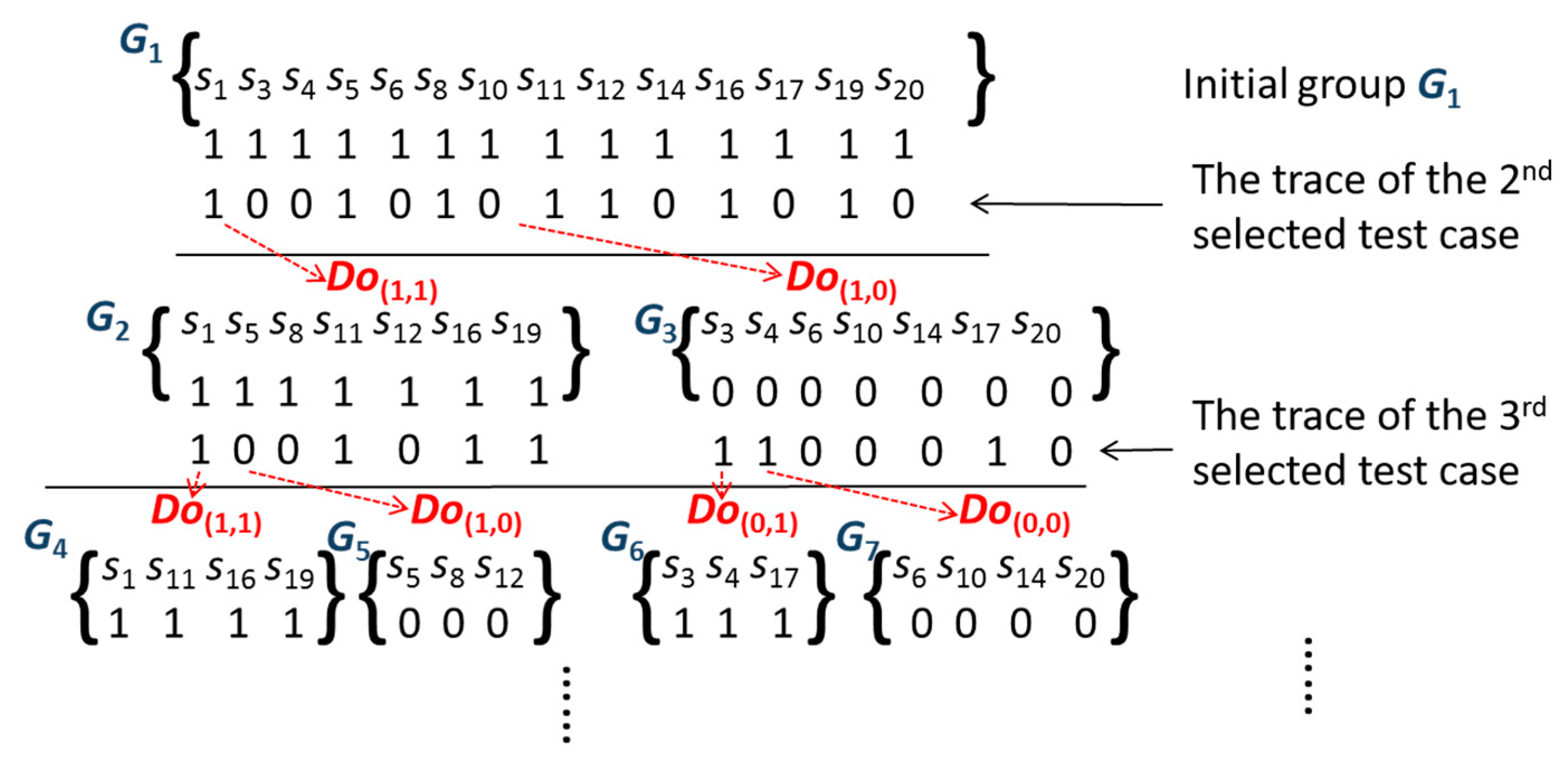
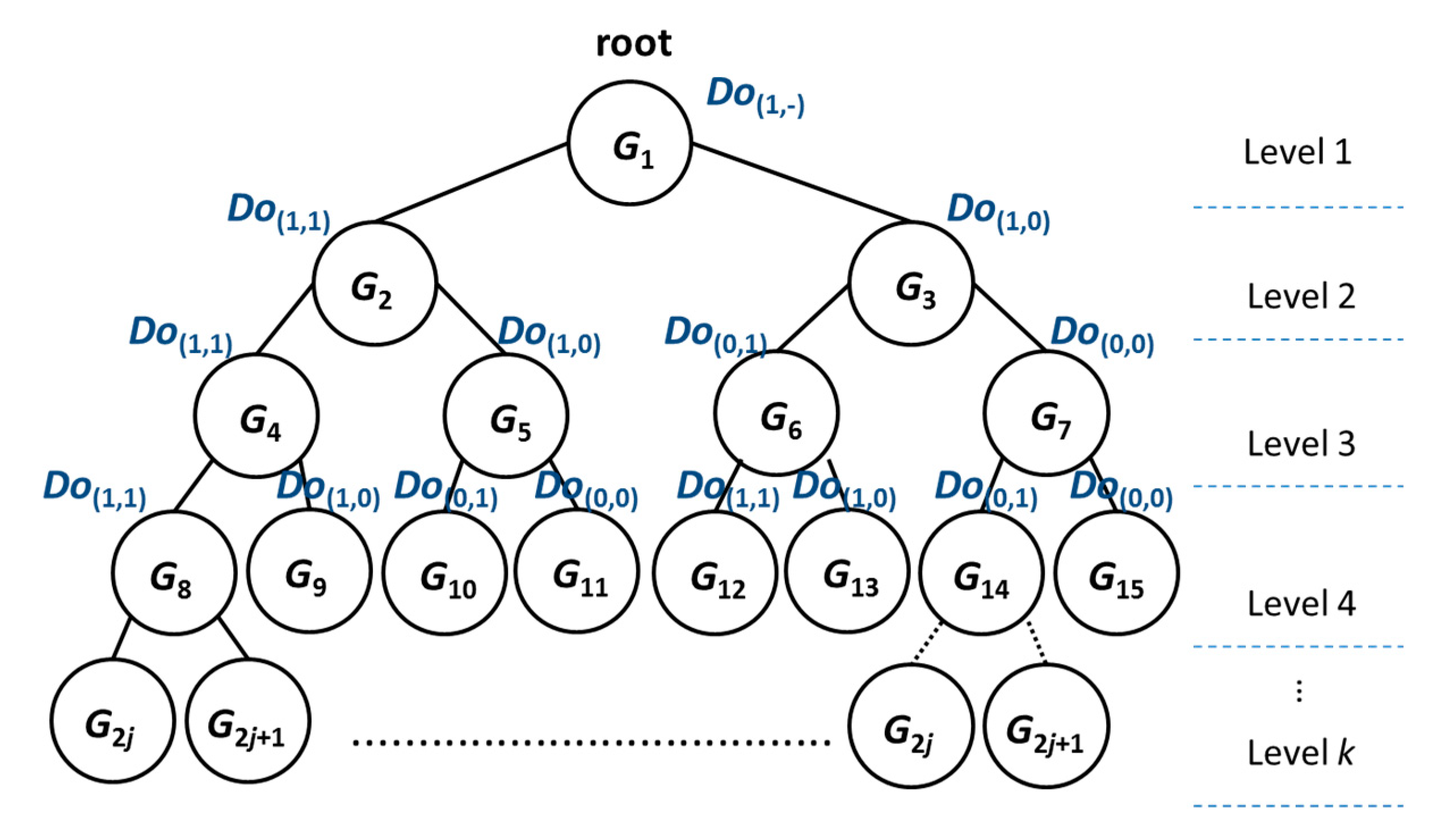

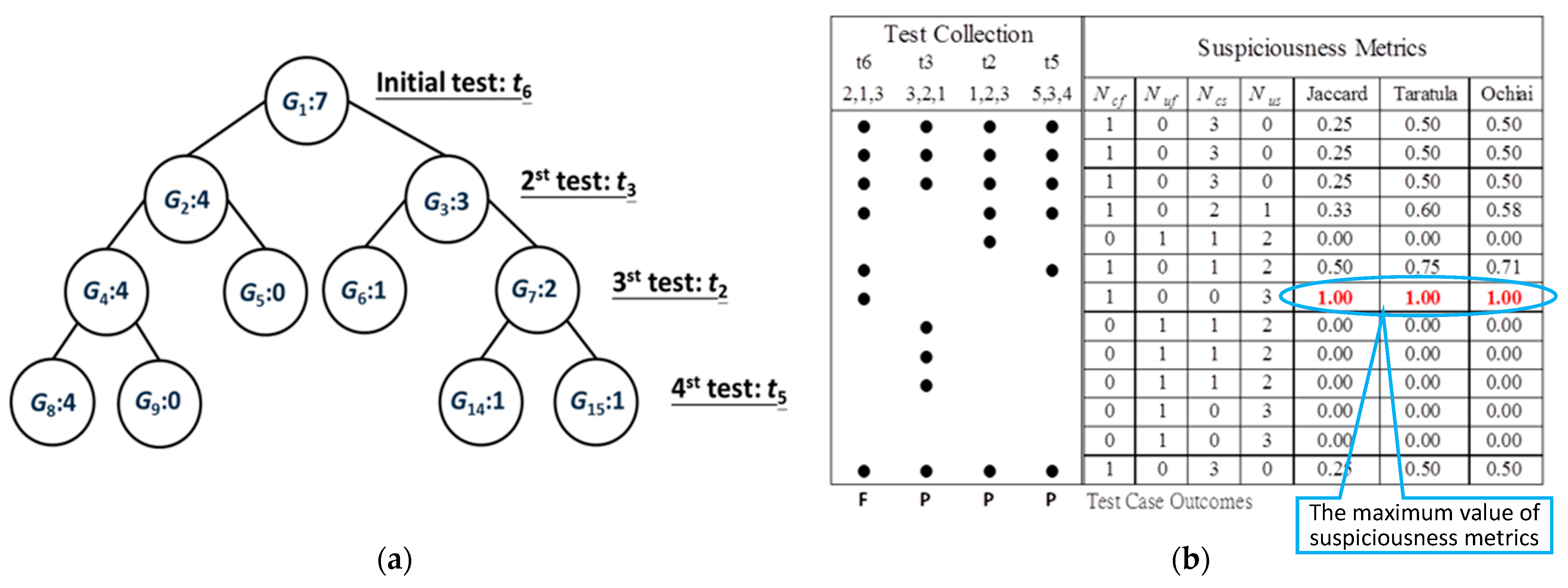
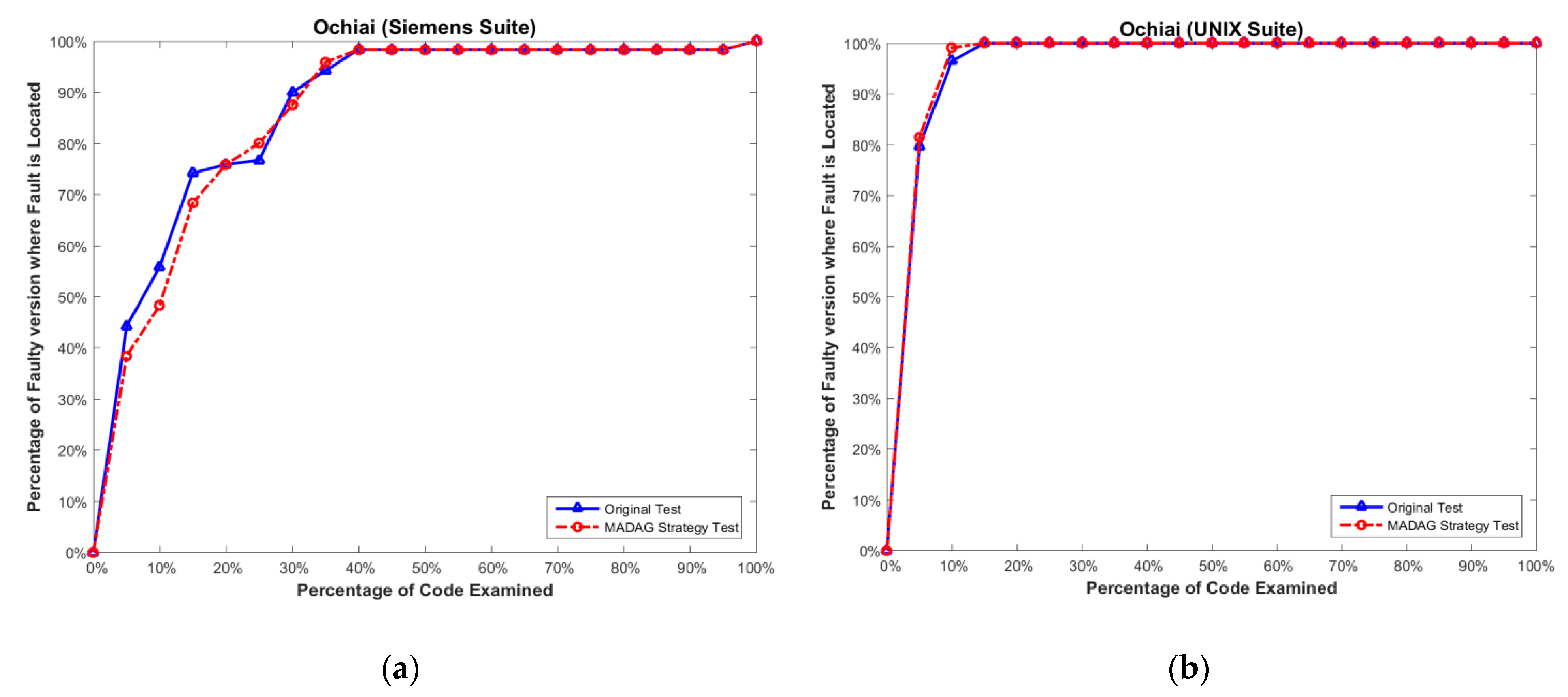
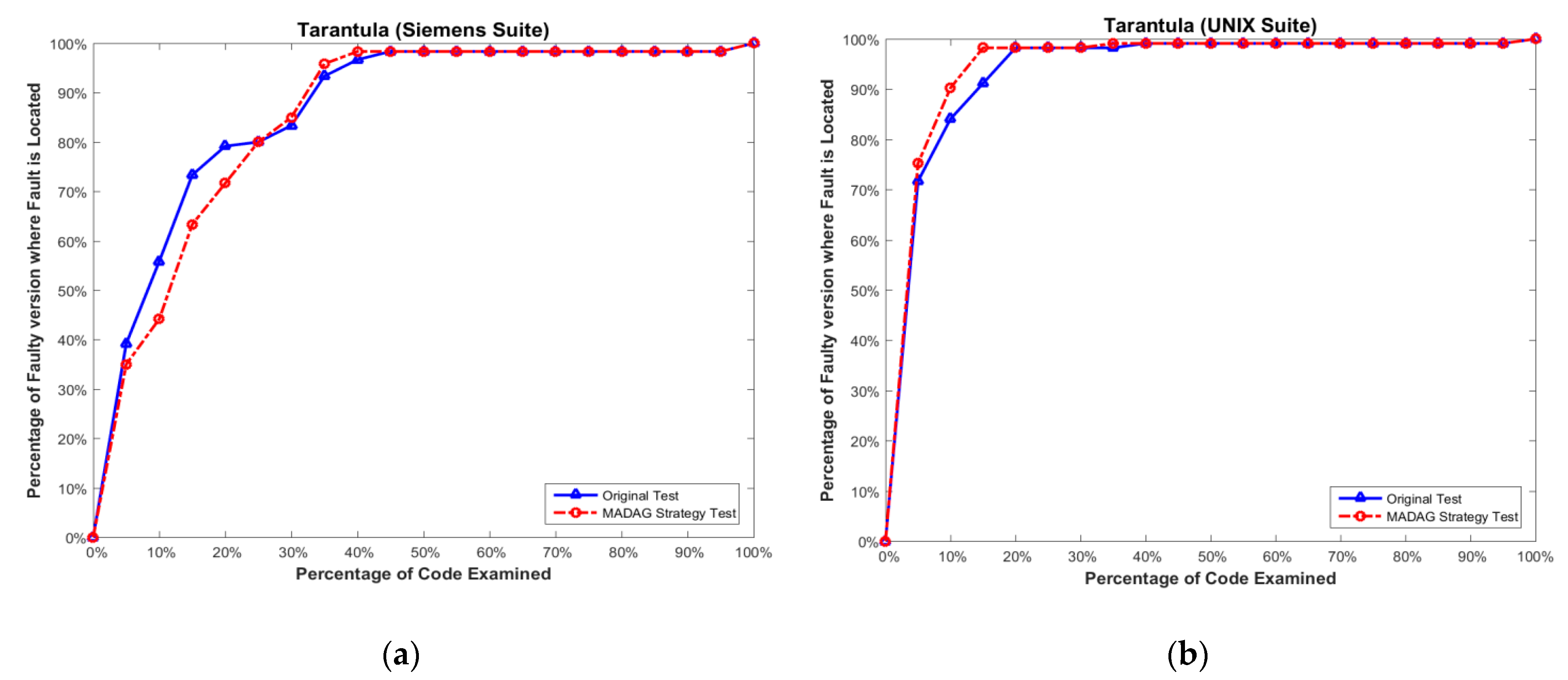
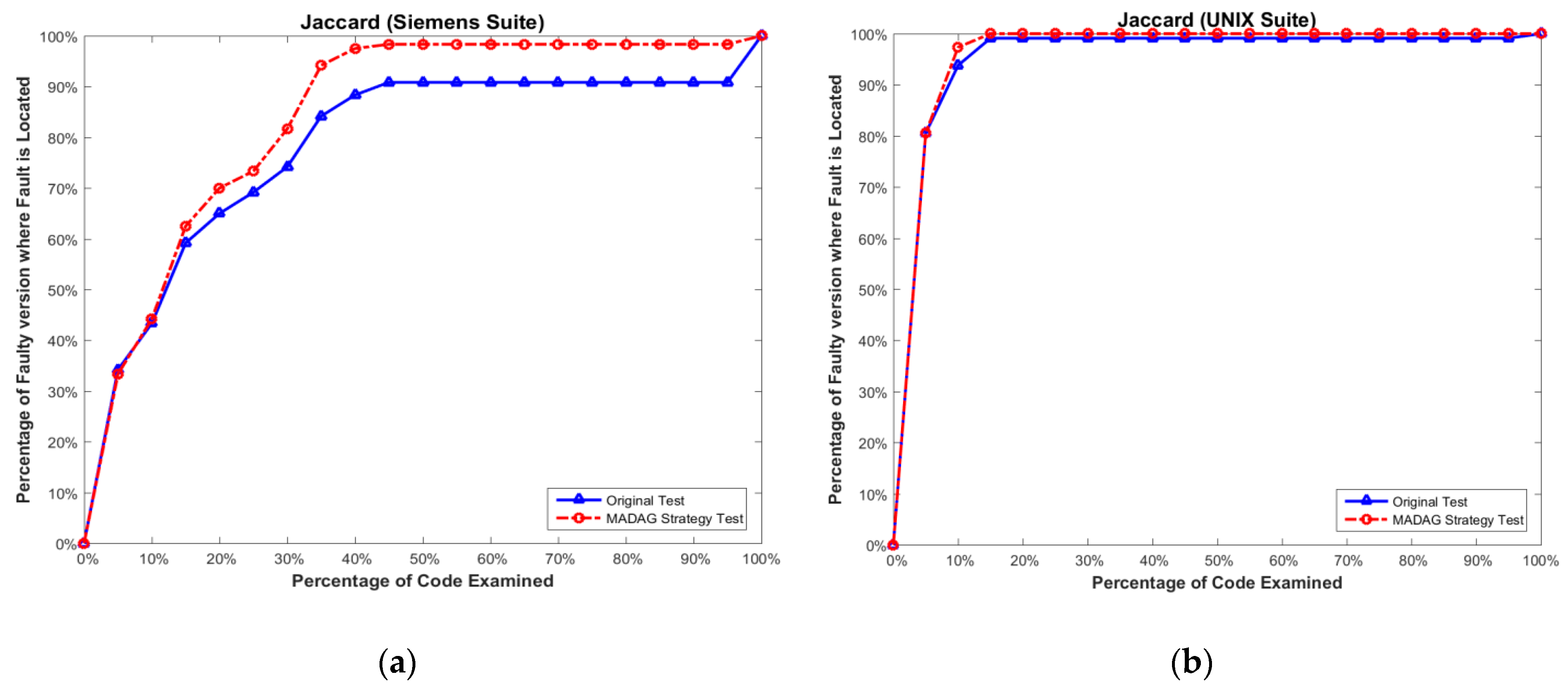
| Time | Name | Authors | Title 3 |
|---|---|---|---|
| 2002 | Jaccard | Chen et al. [17] | |
| 2005 | Tarantula | Jones et al. [18] | |
| 2007 | Ochiai | Abreu et al. [1] |
| k Level | ST | Groups | Groups Elements | To Select Test ti | Mi(ti) |
|---|---|---|---|---|---|
| 1 | {t6} | G1 | {s1, s2, s3, s4, s6, s7, s13} | ||
| 2 | {t6, t3} | G2 | {s1, s2, s3, s13} | t1 | 7 |
| G3 | {s4, s6, s7} | t2 | 3 | ||
| t3 | 1 | ||||
| t4 | 1 | ||||
| t5 | 5 | ||||
| 3 | {t6, t3, t2} | G4 | {s1, s2, s3, s13} | t1 | 7 |
| G5 | {} | t2 | 5 | ||
| G6 | {s4} | t4 | 7 | ||
| G7 | {s6, s7} | t5 | 5 | ||
| 4 | { t6, t3, t2, t5} | G8 | {s1, s2, s3, s13} | t1 | 7 |
| G9 | {} | t4 | 7 | ||
| G14 | {s6} | t5 | 5 | ||
| G15 | {s6} | ||||
| 5 | { t6, t3, t2, t5} | G16 | {s1, s2, s3, s13} | t1 | 6 |
| G17 | {} | t4 | 6 |
| Program | Description | LOC | Test Case | Faculty Versions |
|---|---|---|---|---|
| printtokens | Lexical analyzer | 563–564 | 4130 | 5 |
| printtokens2 | Lexical analyzer | 504–510 | 4115 | 9 |
| schedule | Priority scheduler | 307–308 | 2650 | 5 |
| schedule2 | priority scheduler | 173–179 | 2710 | 9 |
| tcas | Altitude separator | 563–566 | 1608 | 40 |
| totinfo | Info measurer | 406 | 1052 | 23 |
| replace | Pattern replacer | 412–414 | 5542 | 29 |
| space | ADL compiler | 9126 | 13,585 | 29 |
| grep | Text processor | 12,653–13,372 | 470 | 13 |
| gzip | Data compressor | 6576–7996 | 214 | 15 |
| flex | Lexical parser | 12,424–14,245 | 525 | 47 |
| sed | Text processor | 10,055–11,990 | 360 | 9 |
| Program | Total TS | Ochiai | Tarantula | Jaccard | |||
|---|---|---|---|---|---|---|---|
| Test Cases | Ratio | Test Cases | Ratio | Test Cases | Ratio | ||
| printtokens | 4130 | 8.40 | 99.797% | 6.60 | 99.840% | 6.20 | 99.850% |
| printtokens2 | 4115 | 11.78 | 99.714% | 13.11 | 99.681% | 10.89 | 99.735% |
| schedule | 2650 | 10.80 | 99.592% | 9.60 | 99.638% | 9.00 | 99.660% |
| schedule2 | 2710 | 9.22 | 99.660% | 9.00 | 99.668% | 3.89 | 99.856% |
| tcas | 1608 | 4.78 | 99.703% | 4.08 | 99.747% | 3.38 | 99.790% |
| totinfo | 1052 | 7.13 | 99.322% | 9.35 | 99.111% | 5.17 | 99.508% |
| replace | 5542 | 17.62 | 99.682% | 18.17 | 99.672% | 10.55 | 99.810% |
| Siemens Avg. | 9.96 | 99.639% | 9.99 | 99.622% | 7.01 | 99.744% | |
| grep | 470 | 9.69 | 97.938% | 10.85 | 97.692% | 10.38 | 97.791% |
| gzip | 214 | 12.47 | 94.174% | 12.07 | 94.361% | 12.20 | 94.299% |
| flex | 525 | 13.09 | 97.508% | 10.57 | 97.986% | 13.85 | 97.362% |
| sed | 360 | 13.56 | 96.235% | 18.44 | 94.877% | 13.56 | 97.235% |
| space | 13,585 | 22.93 | 99.831% | 17.62 | 99.870% | 22.76 | 99.832% |
| UNIX Avg. | 14.35 | 97.137% | 13.91 | 96.957% | 14.55 | 97.104% | |
| Subject Programs | MADAG | DMS | RAPTOR | FEP | ART-MIN | SEQUOIA | Total-Statement | Add-Statement |
|---|---|---|---|---|---|---|---|---|
| Siemens | Och:10.0 * Tar:10.0 * Jac:7.0 * | 18 | 20 | 97 | 150 | 500+ | 500+ | 500+ |
| UNIX | Och:14.4 * Tar:13.9 * Jac:14.6 * | 16 | 48 | 98 | 56 | 176 | 500+ | 150 |
Disclaimer/Publisher’s Note: The statements, opinions and data contained in all publications are solely those of the individual author(s) and contributor(s) and not of MDPI and/or the editor(s). MDPI and/or the editor(s) disclaim responsibility for any injury to people or property resulting from any ideas, methods, instructions or products referred to in the content. |
© 2023 by the authors. Licensee MDPI, Basel, Switzerland. This article is an open access article distributed under the terms and conditions of the Creative Commons Attribution (CC BY) license (https://creativecommons.org/licenses/by/4.0/).
Share and Cite
Wu, S.-D.; Lo, J.-H. The MADAG Strategy for Fault Location Techniques. Appl. Sci. 2023, 13, 819. https://doi.org/10.3390/app13020819
Wu S-D, Lo J-H. The MADAG Strategy for Fault Location Techniques. Applied Sciences. 2023; 13(2):819. https://doi.org/10.3390/app13020819
Chicago/Turabian StyleWu, Shih-DA, and Jung-Hua Lo. 2023. "The MADAG Strategy for Fault Location Techniques" Applied Sciences 13, no. 2: 819. https://doi.org/10.3390/app13020819
APA StyleWu, S.-D., & Lo, J.-H. (2023). The MADAG Strategy for Fault Location Techniques. Applied Sciences, 13(2), 819. https://doi.org/10.3390/app13020819








